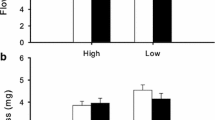Abstract
The sexual and asexual reproductive features of the graminoid species Arundinella hirta growing at riversides of the Jialing River were analyzed. It was found that the total seed mass, seed number per plant, and sexual reproductive allocation of A. hirta decreased with decreasing bank elevation, and plants growing at the lowest elevations of banks subjected to intense flooding did not show sexual reproduction. The total plant biomass and the number of ramifications per plant increased with flooding intensity, which implies that, contrary to sexual reproduction, asexual reproduction of A. hirtawas enhanced by flooding.
Similar content being viewed by others
References
Botany Institute of Chinese Academy of Science, Iconographia Cormophytorum Sinicorum (Tomus V), Beijing: Science Press, 1976, 154 (in Chinese)
Parker G. A. and Smith J. M., Optimality theory in evolutionary biology, Nature, 1990, 348: 27–33
Van der Sman A. J., Joosten N. N. and Blom C. W., Flooding regimes and life-history characteristics of short-lived species in river forelands, J. Ecol., 1993, 81: 121–130
Van der Sman A. J. and Van Tonger O. F., Growth and reproduction of Rumex maritimus and Chenopodium rubrum under different waterlogging regimes, Acta Bot. Neerl., 1988, 37: 439–450
Chongqing Institute of Educational Science, Chongqing Geography, Chongqing: Southwest China Normal University Press, 2003, 2–14 (in Chinese)
Sheng Y. and Yang Y., Comparison of sexual reproduction of Chloris virgata population of two communities in the Songnen plain of China, J. Northeast Norm. Univ., 2000, 32(2): 51–54
Zhang C. H. and Yang Y. F., Analysis of quantitative characters on reproductive tillers in Hierochloe glabra population in the Songnen Plain China, Acta Prataculturae Sin., 2001, 10(3): 1–7
Zhong Z. C., Mechanisms on Ecological Adaptations of Plant Population, Beijing: Science Press, 2000, 80–88
Armstrong W., Rrandle R. and Jackson M. B., Mechanisms of flood tolerance in plants, Acta Bot. Neerl., 1994, 43: 307–358
Blom C. W., Voesenek L. A. and Banga M., Physiological ecology of riverside species: adaptive response of plants to submergence, Ann. Bot., 1994, 74: 253–263
Vartapetian B. B., Andreeva I. N. and Generozova I. P., Functional electron microscopy in studies of plant response and adaptation to anaerobic stress, Ann. Bot., 2003, 91: 155–172
Visser E. J., Voesenek L. A. and Vartapetian B. B., Flooding and plant growth, Ann. Bot., 2003, 91: 107–109
Author information
Authors and Affiliations
Corresponding author
Additional information
Translated from the Journal of Southwest China Normal University (Natural Science), 2005, 30(2) (in Chinese)
Rights and permissions
About this article
Cite this article
Zeng, B., Fu, T., Ulrich, S. et al. Different Responses of Sexual and Asexual Reproduction of Arundinella hirta to Flooding. Front. Biol. China 1, 46–49 (2006). https://doi.org/10.1007/s11515-005-0012-5
Issue Date:
DOI: https://doi.org/10.1007/s11515-005-0012-5




